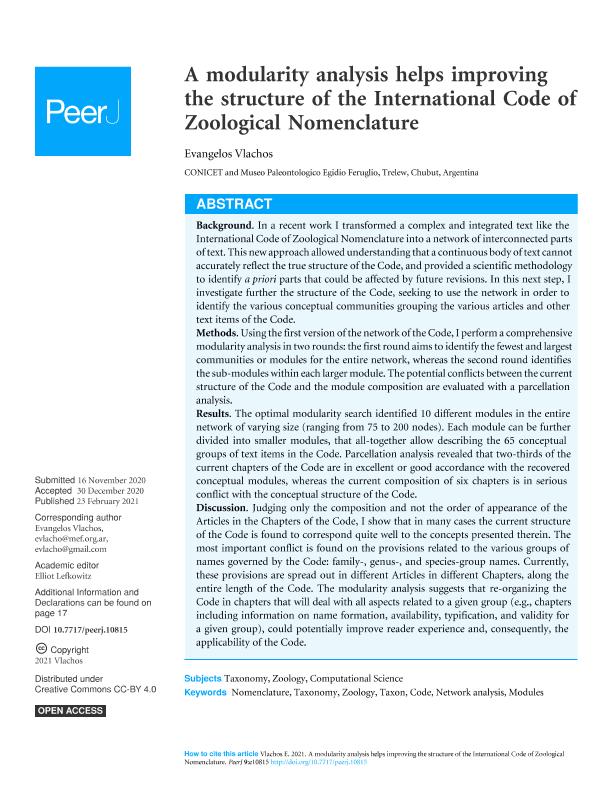Mostrar el registro sencillo del ítem
dc.contributor.author
Vlachos, Evangelos

dc.date.available
2022-04-12T19:40:04Z
dc.date.issued
2021-02-23
dc.identifier.citation
Vlachos, Evangelos; A modularity analysis helps improving the structure of the International Code of Zoological Nomenclature; PeerJ; PeerJ; e10815; 23-2-2021; 1-17
dc.identifier.issn
2167-8359
dc.identifier.uri
http://hdl.handle.net/11336/155113
dc.description.abstract
Background. In a recent work I transformed a complex and integrated text like the International Code of Zoological Nomenclature into a network of interconnected parts of text. This new approach allowed understanding that a continuous body of text cannot accurately reflect the true structure of the Code, and provided a scientific methodology to identify a priori parts that could be affected by future revisions. In this next step, I investigate further the structure of the Code, seeking to use the network in order to identify the various conceptual communities grouping the various articles and other text items of the Code. Methods. Using the first version of the network of the Code, I perform a comprehensive modularity analysis in two rounds: the first round aims to identify the fewest and largest communities or modules for the entire network, whereas the second round identifies the sub-modules within each larger module. The potential conflicts between the current structure of the Code and the module composition are evaluated with a parcellation analysis. Results. The optimal modularity search identified 10 different modules in the entire network of varying size (ranging from 75 to 200 nodes). Each module can be further divided into smaller modules, that all-together allow describing the 65 conceptual groups of text items in the Code. Parcellation analysis revealed that two-thirds of the current chapters of the Code are in excellent or good accordance with the recovered conceptual modules, whereas the current composition of six chapters is in serious conflict with the conceptual structure of the Code. Discussion. Judging only the composition and not the order of appearance of the Articles in the Chapters of the Code, I show that in many cases the current structure of the Code is found to correspond quite well to the concepts presented therein. The most important conflict is found on the provisions related to the various groups of names governed by the Code: family-, genus-, and species-group names. Currently, these provisions are spread out in different Articles in different Chapters, along the entire length of the Code. The modularity analysis suggests that re-organizing the Code in chapters that will deal with all aspects related to a given group (e.g., chapters including information on name formation, availability, typification, and validity for a given group), could potentially improve reader experience and, consequently, the applicability of the Code.
dc.format
application/pdf
dc.language.iso
eng
dc.publisher
PeerJ
dc.rights
info:eu-repo/semantics/openAccess
dc.rights.uri
https://creativecommons.org/licenses/by/2.5/ar/
dc.subject
ZOOLOGY
dc.subject
NETWORK
dc.subject
MODULARITY
dc.subject
TAXONOMY
dc.subject
CODE
dc.subject.classification
Zoología, Ornitología, Entomología, Etología

dc.subject.classification
Ciencias Biológicas

dc.subject.classification
CIENCIAS NATURALES Y EXACTAS

dc.title
A modularity analysis helps improving the structure of the International Code of Zoological Nomenclature
dc.type
info:eu-repo/semantics/article
dc.type
info:ar-repo/semantics/artículo
dc.type
info:eu-repo/semantics/publishedVersion
dc.date.updated
2022-04-07T20:52:35Z
dc.journal.number
e10815
dc.journal.pagination
1-17
dc.journal.pais
Estados Unidos

dc.description.fil
Fil: Vlachos, Evangelos. Museo Paleontológico Egidio Feruglio; Argentina. Consejo Nacional de Investigaciones Científicas y Técnicas; Argentina
dc.journal.title
PeerJ
dc.relation.alternativeid
info:eu-repo/semantics/altIdentifier/url/https://peerj.com/articles/10815/
dc.relation.alternativeid
info:eu-repo/semantics/altIdentifier/doi/https://doi.org/10.7717/peerj.10815
Archivos asociados
